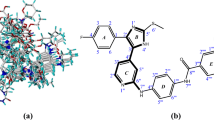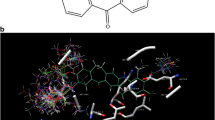Abstract
P38 kinases are the members of serine/threonine kinases family and play a vital role in the progression of inflammation. In the past two decades, numerous p38 kinase inhibitors have been reported, and few of them have failed in clinical trials. Recently, some of the p38 kinase inhibitors have entered in clinical trials for the treatment of Alzheimer’s disease. A potential opportunity exists for medicinal chemistry for the discovery of potent and safe p38 kinase inhibitors. In view of this challenging opportunity, the present manuscript is aimed towards development of a 3D quantitative structure–activity relationship (QSAR) model and the docking and dynamic simulation studies. A statistically robust 3D QSAR model was developed by employing 21 training set molecules which is attributed with appreciating cross-validation coefficient (q2) of 0.0.6269 and conventional correlation coefficient (r2) of 0.8783 respectively. The predicted correlation coefficient (r2 pred) was found to be 0.8644 and standard error of 0.3331. The molecular docking analysis of all the p38 kinase inhibitors revealed that the analogs were well docked into the DFG (Asp-Phe-Gly motif) out pocket of p38 kinase and exhibited hydrogen bond interactions with Asp186 and Lys71. Extension of docking studies to the molecular dynamics simulation study informed that the ligand displayed the strong conformational stability within the active site of p38 kinase forming maximum two hydrogen bonds until 100 ns respectively.












Similar content being viewed by others
Availability of data and materials
All the data out from software have been included in the manuscript.
Code availability
We have used maximum GUI-based software except gromacs which is used for molecular dynamic simulation on UBUNTU. Commands have been executed which are available free in public domain as referred. We have not created any new codes during the entire study.
References
Kulkarni RG, Achaiah G, Sastry GN (2006) Novel targets for anti-inflammatory and anti-arthritic agents. Cur Pharma Des 12:2437–2524. https://doi.org/10.2174/138161206777698945
Ravindra GK, Achaiah G, Sastry GN (2008) Molecular modeling studies of phenoxypyrimidinyl imidazoles as p38 kinase inhibitors using QSAR and docking. Eur J Med Chem 43(4):830–838. https://doi.org/10.1016/j.ejmech.2007.06.009
Cuenda A, Rousseau S (2007) p38 MAP-kinases pathway regulation, function and role in human diseases. Bioche et Biophy Acta BBA Mol Cell Res 1773(8):1358–1375. https://doi.org/10.1016/j.bbamcr.2007.03.010
Hu MC, Wang YP, Mikhail A, Qiu WR, Tan TH (1999) Murine p38-δ mitogen-activated protein kinase, a developmentally regulated protein kinase that is activated by stress and proinflammatory cytokines. J Biol Chem 274(11):7095–7102. https://doi.org/10.1074/jbc.274.11.7095
Chakravarty S, Dugar S, Perumattam J, Schreiner GF, Liu DY, Lewicki JA (2000) Quinazoline derivatives as medicaments. WO00/12497.
Psomadakis CE, Han G (2019) New and emerging topical therapies for psoriasis and atopic dermatitis. J Clin Aesthet Dermatol 12(12):28–34
Fehr S, Unger A, Schaeffeler E, Herrmann S, Laufer S, Schwab M, Albrecht W (2015) Impact of p38 MAP kinase inhibitors on LPS-induced release of TNF-α in whole blood and primary cells from different species. Cell Physiol Biochem 36(6):2237–2249. https://doi.org/10.1159/000430188
Cohen SB, Cheng TT, Chindalore V, Damjanov N, Burgos-Vargas R, DeLora P, Zimany K, Travers H, Caulfield JP (2009) Evaluation of the efficacy and safety of pamapimod, a p38 MAP kinase inhibitor, in a double-blind, methotrexate-controlled study of patients with active rheumatoid arthritis. Arthr Rheum 60(2):335–344. https://doi.org/10.1002/art.24266
Pargellis C, Tong L, Churchill L, Cirillo PF, Gilmore T, Graham AG, Grob PM, Hickey ER, Moss N, Pav S, Regan J (2002) Inhibition of p38 MAP kinase by utilizing a novel allosteric binding site. Nature Struct Biol 268–72. https://doi.org/10.1038/nsb770
Duffy JP, Harrington EM, Bellon SF, Chen G, Taslimi P, Jones P, Huang C, Pazhanisamy S, Wang YM, Murcko MA, Su MSS (2011) The discovery of VX-745: a novel and selective p38α kinase inhibitor. ACS Med Chem Lett 2(10):758–763
Haller V, Nahidino P, Forster M, Laufer SA (2020) An updated patent review of p38 MAP kinase inhibitors (2014–2019). Expert Opin Therap Patents 30(6):453–466. https://doi.org/10.1080/13543776.2020.1749263
Kulkarni RG, Palukuri S, Garlapati A, Sastry GN (2007) Strategies to design pyrazolyl urea derivatives for p38 kinase inhibition: a molecular modeling study. J Comput Aided Mol Des 21:155–166
Mahaveer P, Kulkarni RG, Radhakrishna P, Chandrashekar VM, Achaiah G (2013) Synthesis and anti-inflammatory activity of ketoamides of pyrazole. Ind J Chem B 52B:818–823
Ganesh A, Bikshapathi D, Kulkarni R (2018) Pyrazolyl benzamides: synthesis, characterization and potent biological activity, part-2. Cur Enz Inh 14(1):26–35. https://doi.org/10.2174/1573408013666170516143419
Ravindra GK, Achaiah G, Laufer S, Chandrashekar VM (2013) Synthesis, anti-inflammatory and p38 kinase inhibitory activity of N, N′-diaryl urea derivatives. Med Chem 9:213–221. https://doi.org/10.2174/1573406411309020006
Kulkarni RG, Diwyani S, Laufer S, VM C, Gurav P, Habbu P, (2015) Anti-inflammatory activities of phenoxyphenyl ureas mediated by inhibition of p38 kinase. Cur Enz Inh 11(2):116–123. https://doi.org/10.2174/1573408011666150729221843
Fatima A, Kulkarni RG, Mantripagada B, Mohammed A, Birajdar A, Chandrasheskar VM (2014) Synthesis, characterization and anti-inflammatory activity of N-(4-phenyl-1, 3-thiazol-2-yl)-N′-phenylureas. Anti-Inflamm Anti-Allergy Agents Med Chem 13(2):112–120. https://doi.org/10.2174/1871523013666140820154843
Kulkarni R, Kompalli K, Gaddam N, Mangannavar CV, Darna B, Garlapati A, Kumar D, Machha B (2021) Synthesis, characterization, antitubercular and anti-inflammatory activity of new pyrazolo [3, 4-d] pyrimidines. Comb Chem High Through Screen 24(8):1300–1308. https://doi.org/10.2174/1386207323999200918114905
Kulkarni RG, Laufer S, Chandrashekar VM, Garlapati A (2013) Synthesis, p38 kinase inhibitory and anti-inflammatory activity of new substituted benzimidazole derivatives. Med Chem 9(1):91–99. https://doi.org/10.2174/157340613804488440
Millan DS, Bunnage ME, Burrows JL, Butcher KJ, Dodd PG, Evans TJ, Fairman DA, Hughes SJ, Kilty IC, Lemaitre A, Lewthwaite RA (2011) Design and synthesis of inhaled p38 inhibitors for the treatment of chronic obstructive pulmonary disease. J Med Chem 54(22):7797–7814. https://doi.org/10.1021/jm200677b
Halgren TA (1996) Merck molecular force field III Molecular geometries and vibrational frequencies for MMFF94. J Comput Chem 17(5–6):553–586
Ajmani S, Kulkarni SA (2008) A dual-response partial least squares regression qsar model and its application in design of dual activators of PPARα and PPARγ. QSAR Comb Science. https://doi.org/10.1002/qsar.200810023
Ajmani S, Jadhav K, Kulkarni SA (2006) Three-dimensional QSAR using the k-nearest neighbor method and its interpretation. J Chem Inf Model. https://doi.org/10.1021/ci0501286
Ghosh P, Bagchi MC (2009) Comparative QSAR studies of nitrofuranyl amide derivatives using theoretical structural properties. Mol Simul 35(14):1185–1200
Bhatia MS, Pakhare KD, Choudhari PB, Jadhav SD, Dhavale RP, Bhatia NM (2017) Pharmacophore modeling and 3D QSAR studies of aryl amine derivatives as potential lumazine synthase inhibitors. Arab J Chem 10:100–104
Golbraikh A, Tropsha A (2002) Beware of q2! J Mol Graph Model 20(4):269–276
Makhija MT, Kulkarni VM (2002) 3D-QSAR and molecular modeling of HIV-1 integrase inhibitors. J Comput Aided Mol Des 16(3):181–200
Friesner RA, Banks JL, Murphy RB, Halgren TA, Klicic JJ, Mainz DT, Repasky MP, Knoll EH, Shelley M, Perry JK, Shaw DE (2004) Glide a new approach for rapid accurate docking and scoring 1 Method and assessment of docking accuracy. J Med Chem 47(7):1739–1749. https://doi.org/10.1021/jm0306430
Friesner RA, Murphy RB, Repasky MP, Frye LL, Greenwood JR, Halgren TA, Sanschagrin PC, Mainz DT (2006) Extra precision glide: docking and scoring incorporating a model of hydrophobic enclosure for protei–ligand complexes. J Med Chem 49(21):6177–6196. https://doi.org/10.1021/jm051256o
Modi SJ, Kulkarni VM (2020) Discovery of VEGFR-2 inhibitors exerting significant anticancer activity against CD44+ and CD133+ cancer stem cells (CSCs): reversal of TGF-β induced epithelial-mesenchymal transition (EMT) in hepatocellular carcinoma. Eur J Med Chem 207:112851
Schrödinger L, DeLano W (2020) The PyMOL molecular graphics system Schrödinger version 2.1.1. Schrödinger, LLC
Dassault Systèmes BIOVIA Discovery Studio Version 4.5 (2020)
Šali A, Blundell TL (1993) Comparative protein modelling by satisfaction of spatial restraints. J Mol Biol 234(3):779–815. https://doi.org/10.1006/jmbi.1993.1626
Macha B, Kulkarni R, Bagul C, Garige AK, Akkinepally R, Garlapati A (2021) Molecular hybridization based design and synthesis of new benzo [5, 6] chromeno [2, 3-b]-quinolin-13 (14H)-one analogs as cholinesterase inhibitors. Med Chem Res 30(3):685–701
Hess B, Kutzner C, Van Der Spoel D, Lindahl E (2008) GROMACS 4: algorithms for highly efficient, load-balanced, and scalable molecular simulation. J Chem Theory Comput 4(3):435–447
Abraham MJ, Murtolad T, Schulz R, Pálla S, Smith JC, Hess B, Lindahl E (2015) GROMACS: high performance molecular simulations through multi-level parallelism from laptops to supercomputers. SoftwareX 1:19–25
Schmid N, Eichenberger AP, Choutko A, Riniker S, Winger M, Mark AE, van Gunsteren WF (2011) Definition and testing of the GROMOS force-field versions 54A7 and 54B7. Eur Biophys J 40(7):843–856
Stroet M, Caron B, Visscher KM, Geerke DP, Malde AK, Mark AE (2018) Automated topology builder version 30 prediction of solvation free enthalpies in water and hexane. J Chem Theory Comput 14(11):5834–5845
Pronk S, Páll S, Schulz R, Larsson P, Bjelkmar P, Apostolov R, Shirts MR, Smith JC, Kasson PM, van der Spoel D, Hess B, Lindahl E (2013) GROMACS 45 a high throughput and highly parallel open source molecular simulation toolkit. Bioinform 29(7):845–854. https://doi.org/10.1093/bioinformatics/btt055
Acknowledgements
Corresponding author RK expresses gratitude to Dr. AP Pawar in charge principal Poona College of Pharmacy, Pune and AC and MK thank Schrodinger Bangalore for granting 1-month trial license which helped us in docking studies to our laboratory mate Mr. Jagannath Shinge.
Author information
Authors and Affiliations
Contributions
CA: project execution and writing; KM: compilation of data; BC: execution of molecular modeling studies especially MD; AM: data compilation and manuscript correction; RK: projection conception, planning, data collection and manuscript construction.
Corresponding author
Ethics declarations
Conflict of interest
The authors declare no competing interests.
Additional information
Publisher's Note
Springer Nature remains neutral with regard to jurisdictional claims in published maps and institutional affiliations.
Rights and permissions
Springer Nature or its licensor holds exclusive rights to this article under a publishing agreement with the author(s) or other rightsholder(s); author self-archiving of the accepted manuscript version of this article is solely governed by the terms of such publishing agreement and applicable law.
About this article
Cite this article
Aasiya, C., Mangala, K., Chandrakant, B. et al. Investigation of structure–activity relationship: In silico studies of [1, 2, 4]triazolo[4, 3-a]pyridine ureas as P38 kinase inhibitors. Struct Chem 34, 915–929 (2023). https://doi.org/10.1007/s11224-022-02046-3
Received:
Accepted:
Published:
Issue Date:
DOI: https://doi.org/10.1007/s11224-022-02046-3




